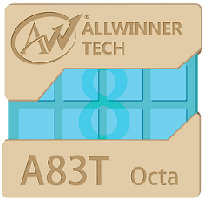 So Allwinner has just announced a new processor. I’ve been disappointed recently when I discovered AllWinner A80 only supports Linux 3.4, whereas most competitors are running Android 3.10 stable kernel, and their partner is distributing A80 OptimusBoard development boards, which looks to be a nice hardware platform, but without any Android or Linux SDK… And with their latest press release you have to wonder… They announced AllWinner A83T processor with “eight highly energy-efficient Cortex-A7 cores that could run simultaneously at around 2.0GHz, and implements the advanced big.LITTLE architecture to maximize the battery life”. The only problem is that with big.LITTLE you need big and LITTLE core, and if AllWinner A83T is just having eight Cortex A7 cores, there’s no big to be found… I guess that just means they can turn cores on and off independently…
So Allwinner has just announced a new processor. I’ve been disappointed recently when I discovered AllWinner A80 only supports Linux 3.4, whereas most competitors are running Android 3.10 stable kernel, and their partner is distributing A80 OptimusBoard development boards, which looks to be a nice hardware platform, but without any Android or Linux SDK… And with their latest press release you have to wonder… They announced AllWinner A83T processor with “eight highly energy-efficient Cortex-A7 cores that could run simultaneously at around 2.0GHz, and implements the advanced big.LITTLE architecture to maximize the battery life”. The only problem is that with big.LITTLE you need big and LITTLE core, and if AllWinner A83T is just having eight Cortex A7 cores, there’s no big to be found… I guess that just means they can turn cores on and off independently…
Allwinner must also have adopted Qualcomm or Mediatek press release “strategy”, as they release a little information as possible for their first press release… So right now, we just know the processor will be manufactured using TSMC’s 28-nm HPC processor, the cores will run up to 2.0 GHz, a PowerVR GPU is part of the mix, and it will feature Allwinner’s SmartColor technology to deliver better image quality.
Tablets based on Allwinner A83T should start selling in Q4 2014.

Jean-Luc started CNX Software in 2010 as a part-time endeavor, before quitting his job as a software engineering manager, and starting to write daily news, and reviews full time later in 2011.
Support CNX Software! Donate via cryptocurrencies, become a Patron on Patreon, or purchase goods on Amazon or Aliexpress




Or could they have made 2 clusters of Cortex A7? One cluster limited to say 1.2 GHz, and another to 2.0GHz? Would that make any sense?
@Jean-Luc Aufranc (CNXSoft)
Indeed it would, Nvidia had something similar where it had the same type of cores ( like A9 or A15 ) but running at a lower frequency and using less power. It’s never been done with A7 core but no reason it can’t I suppose.
architecture like as on Qualcomm Snapdragon 615 (quad ARM Cortex A53 @ 1,5 Ghz for Big and quad ARM Cortex A53 @ 1 Ghz for Little)
Where can I read something about the differences between A7 A9 A15 and so on, architectures, that it is explained on a childish level 😉 ?
@Tadej
Have you tried on ARM website? Otherwise.. no ideea. I don’t know where you could find that info, considering the ARM cores are not open source.
@Tadej
simpliest Comparison of ARMv7-A cores ( http://en.wikipedia.org/wiki/Comparison_of_ARMv7-A_cores )
@Tadej
Here you go : http://www.anandtech.com/show/4991/arms-cortex-a7-bringing-cheaper-dualcore-more-power-efficient-highend-devices
http://www.quora.com/ARM-cortex-a7-vs-ARM-cortex-a9-vs-ARM-cortex-a15-what-are-Major-differences-and-which-to-prefer-if-you-need-more-battery-life
There’s probably more stuff out there.
IHMO should be the most energy-efficient out-of order 28nm octa-core SoC if used on a STB or SBC
errata corrige: IMHO should be the most energy-efficient in-of order 28nm octa-core SoC if used on a STB or SBC
@Tadej
http://en.wikipedia.org/wiki/Comparison_of_ARMv7-A_cores
http://en.wikipedia.org/wiki/Comparison_of_ARMv8-A_cores
A9 are classic dual/quad core arm processors
A7/A15 are for little/Big configurations
so if you do something hard to compute your process will be move from A7(low consumption CPU) to A15(high)
A15 has longer pipeline, out of order execution, bigger cache and other nice stuff from big processors(desktop,server) but CPU is bigger so it consume more power
A15 are good for games/ rendering web,…
little/big configurations are nice as phone don’t need A15 processors all the time but when you need something extensive.
@m][sko
Thanks m][sko!
Allwinner A83T details have been released: CPU: • Octa-Core Cortex TM -A7 CPU • Low-power CoolFlex TM power management architecture GPU: • PowerVR SGX544 GPU • Supports OpenGL ES 2.0/1.1, OpenCL 1.1, DX 9_3 Memory: • Supports 32-bit DDR3/DDR3L/LPDDR3/LPDDR2 • Supports SLC/MLC/TLC/EF NAND with 64-bit ECC Video: • Supports eMMC • Supports 1080p@60fps video playback • Supports multi-format video playback, including H.264 BP/MP/HP, H.265/HEVC MP/L5.2, VP8/VP9, MPEG1/2, MPEG4 SP/ASP GMC, H.263 including Sorenson Spark, WMV9/VC-1, JPEG/MJPEG, etc • Supports H.264 1080p@60fps or 720p@120fps video encoding Display: • Supports 4-lane MIPI DSI 1920×1200@60fps • Supports RGB LCD 1920×1200@60fps or LVDS 1366×768@60fps… Read more »